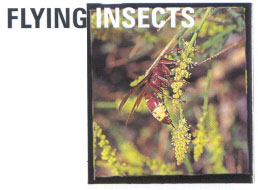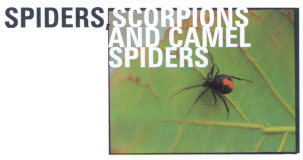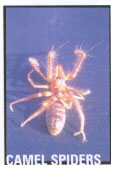|
LIZARDS Over 35 species of lizards have been identified in
the UAE. None of these are poisonous. Although many locals believe that house geckos are poisonous, this is not true. In fact these creatures are very beneficial for us as they keep down the number of flying
and crawling insects in our homes. Another lizard that has the reputation for being poisonous is the largest of the local lizards, the desert monitor or "Wirral". Although this lizard does not
possess any poison, its bite can be very unpleasant. Because it likes to eat carrion its mouth is full of bacteria and this can cause a severe infection if one is bitten. Since the monitor is not very keen
on human company, there is no need to have a close encounter with it.  Of the over 200 species of bees and wasps
that have been identified in the UAE, only a few come into frequent contact with local residents. The local honeybee can sting, but is not at all aggressive, as honey collectors will
confirm. On the other hand the large yellow paper wasp, often called a hornet, is aggressive and will attack at the merest provocation. This wasp likes to build its upside-down nest under shady overhangs
(window frames, balconies, etc.), which brings it into close proximity with people. It is best to remove these nests in the early stage or have them removed by pest control
companies in order to avoid painful stings. Of the over 200 species of bees and wasps
that have been identified in the UAE, only a few come into frequent contact with local residents. The local honeybee can sting, but is not at all aggressive, as honey collectors will
confirm. On the other hand the large yellow paper wasp, often called a hornet, is aggressive and will attack at the merest provocation. This wasp likes to build its upside-down nest under shady overhangs
(window frames, balconies, etc.), which brings it into close proximity with people. It is best to remove these nests in the early stage or have them removed by pest control
companies in order to avoid painful stings.
The large red and yellow Oriental wasp that often bothers people on desert picnics is
also not a welcome visitor. If the picnic takes place anywhere near a nest, it is best to change sites. Mosquitoes are a pest all over the world, because they can carry potentially
dangerous diseases. In the UAE several strains of malaria used to occur as little as ten years ago. In the last decade the fight against mosquitoes has had a positive
effect in this situation. The best strategy to attain a mosquito-free life is to prevent their breeding. Mosquitoes breed in stagnant water, mostly at temperatures over 15º
C and at altitudes below 2000 m. In urban areas it is easy to get rid of stagnant pools and to spray insecticides after rains. But in the countryside where swamps and
pools are part of the landscape and home to a large variety of flora and fauna, it is impossible to fight mosquitoes without doing considerable damage to the
environment. Even the campaign that was carried out several years ago, whereby fish that fed on mosquito-larvae were distributed into the various wadi systems in
the Hajar Mountains, had its drawbacks. The large Tilapia fish dominated the streams and wiped out the indigenous wadi fish, thereby doing irreversible damage to the local echo-system.
Flies are not harmful in themselves but they can carry a multitude of diseases. I have always remembered this sentence from my medical textbooks, studied some 40 years
ago: "Dysentery is a disease that is caused by the fouling of food with fingers and the feet of faecal-feeding flies."  All spiders possess poison, but very few pose a real danger to people's well-being. The only potentially
dangerous one that occurs locally is the Red-back spider, easily recognisable by the hourglass shaped red splotch on its black body. It is very small, and likes to hide in ground-covering vegetation (the
goat-creepers!) and beneath edges of garden furniture. To an adult the bite will only cause discomfort, but a child might suffer worse consequences. Again, prevention is better than the cure, so
check the edges of sandboxes and garden pools, before you let small children play in them. All spiders possess poison, but very few pose a real danger to people's well-being. The only potentially
dangerous one that occurs locally is the Red-back spider, easily recognisable by the hourglass shaped red splotch on its black body. It is very small, and likes to hide in ground-covering vegetation (the
goat-creepers!) and beneath edges of garden furniture. To an adult the bite will only cause discomfort, but a child might suffer worse consequences. Again, prevention is better than the cure, so
check the edges of sandboxes and garden pools, before you let small children play in them.The large yellowish orb-spider that weaves its wonderful webs in many gardens,
poses no threat to people. As it has flying insects as its prey, its presence is beneficial to man.  Many strange stories exist about the camel spider or wind scorpion.
This fearsome-looking creature is not really a spider. It belongs to the order of Solifugidae (those who flee from the sun) - a name that indicates that the creature does not like light. If one is
uncovered from its hiding place in the daytime, it will look for the nearest shade, and the person who uncovered him usually casts that. Since it moves very fast, its headlong dash for the shade is
interpreted as an attack. In fact they are not at all aggressive and do not have any poison. Stories about them eating your face when you are camping out in the desert are just that: stories. Instead of
being given such a bad reputation, camel spiders should be admired for a number of interesting characteristics, such as the maternal care of the female
camel spider for her babies, and the interesting unique paddle-shaped organ they have underneath their bellies, with which they sense vibrations in the ground. Many strange stories exist about the camel spider or wind scorpion.
This fearsome-looking creature is not really a spider. It belongs to the order of Solifugidae (those who flee from the sun) - a name that indicates that the creature does not like light. If one is
uncovered from its hiding place in the daytime, it will look for the nearest shade, and the person who uncovered him usually casts that. Since it moves very fast, its headlong dash for the shade is
interpreted as an attack. In fact they are not at all aggressive and do not have any poison. Stories about them eating your face when you are camping out in the desert are just that: stories. Instead of
being given such a bad reputation, camel spiders should be admired for a number of interesting characteristics, such as the maternal care of the female
camel spider for her babies, and the interesting unique paddle-shaped organ they have underneath their bellies, with which they sense vibrations in the ground.
The number of species of scorpions in the UAE has not yet been determined, but there are certainly more than half a dozen. Their sting is painful and can cause a bad
reaction, but is only really dangerous to very small children. Since they are only active at night, overnight campers mostly encounter them. Avoiding contact is the
best protection. Be careful when rolling up the tent or carpets in the morning as they (and other creatures) could be underneath.
The water scorpion, sometimes found in the wadis, is not a scorpion at all. The tail does not have a sting but is actually a kind of snorkel through which the insect breathes!
MARINE LIFE The possible danger of a sea-snake bite has already been mentioned. Those people
snorkelling or diving along UAE coasts should take care to avoid contact with stonefish, lionfish, scorpion fish and certain jellyfish. Fortunately victims of such
encounters are few and far between. This cannot be said for the victims of a stingray-sting. Since stingrays come in close to the shore every time the seasons
change (from hot to cool and vice versa), many people who are unaware of their existence can have a nasty surprise. The fish lies hidden underneath the sand in the
shallows and it is very easy to step on it. When that happens the stingray whips the 10 cm sting at the base of its tail upwards and usually hits the person near the
ankle. The pain is said to be incredible and lasts for as long as seven or eight hours. The wound can also become severely infected. The best (and only) first aid therapy
is to immerse the wound in water that is as hot as the person can stand (difficult to do with children or dogs!). Afterwards a visit to the doctor is necessary to get some
painkillers and preventive antibiotic treatment. But it is much better to prevent the incident by disturbing the sand of the area where you are going to bathe with a
stick, chasing away any rays that may lie hidden there. It takes a few minutes of careful survey, but it is well worth the effort!
 The Waterscorpion, sometimes found in teh wadis, is not a scorpion at all. The tail does not have a sting but is actually a kind of snorkel through which theinsect breathes!
The Waterscorpion, sometimes found in teh wadis, is not a scorpion at all. The tail does not have a sting but is actually a kind of snorkel through which theinsect breathes!
|
FIRST AID MEASURES
With all dangerous animals, prevention is better than the cure. Since most local animals are only active at night, walking around the desert at night should be done
only if you have a strong light and high walking boots. In the daytime, don't put your hands or feet in places where your eye cannot see!
If a viper bites you, do not attempt to cut or suck the bite site or to apply a tourniquet. First aid consists mainly of reassuring the victim, keeping him calm and
keeping the affected area as still as possible and lower than the heart. That means that if the bite is on a leg, the victim should not walk to the car but be carried. If a
bandage is available, it can be applied as a pressure bandage and if a splint can be made from a branch or stick, then this can be used to keep the affected part
immobile. Then head for the nearest city with a government hospital. In the UAE all the main government hospitals have doctors and nurses that are well trained in the
treatment of snakebites. Administering an anti-toxin is not always necessary and not always desirable, since the risks with that treatment are sometimes greater than the
effect of the snakebite. It is not necessary to kill the snake that caused the bite, as a general description and more importantly mention of the location where the
accident occurred, will be sufficient for the doctors to decide the course of treatment. A useful gadget to give first aid treatment in the case of insect stings and spider
bites is the Aspivenin vacuum pump. This small device can be applied to the area of the bite and sucks out part of the venom by vacuum created by pushing down on
the syringe. I have personally used it in cases of stingray stings and viper bites and have found it extremely useful. Others have reported good success with the
treatment of paper wasp stings. The device is available in local pharmacies and is very easy and safe to use. The most life-threatening situation occurs when a person is allergic to the venom
injected. Fortunately a first sting or bite is usually not fatal, but can cause serious conditions, such as anaphylactic shock (failure of the circulatory system) or
Quincke's oedema (a swelling of the throat, hindering breathing). A subsequent incident is usually much more severe and definitely dangerous. Therefore people
known to be allergic should always carry an emergency kit, consisting of injectable adrenaline and antihistamines. With this extra protection even allergic people should be able to enjoy the desert
without fear. |
